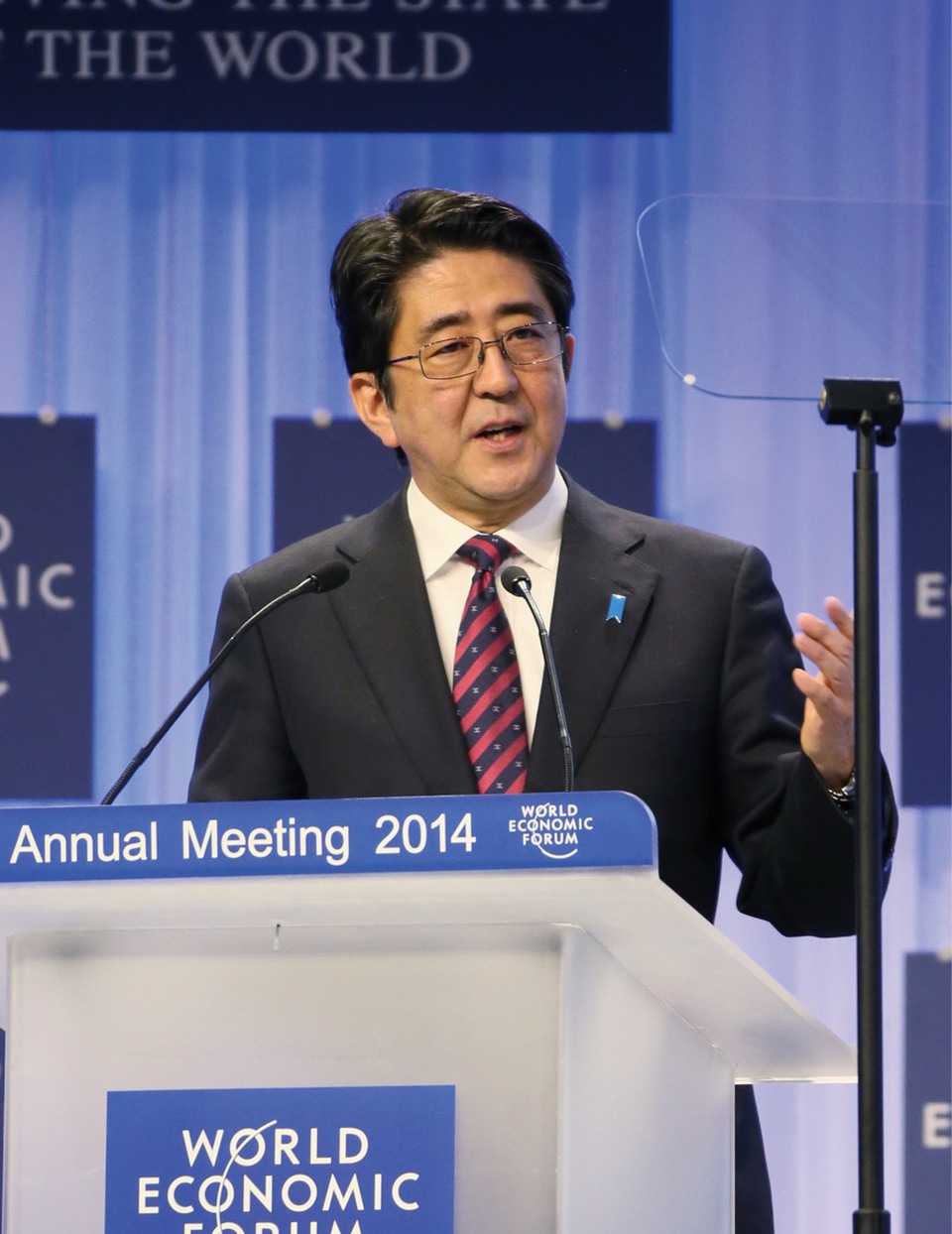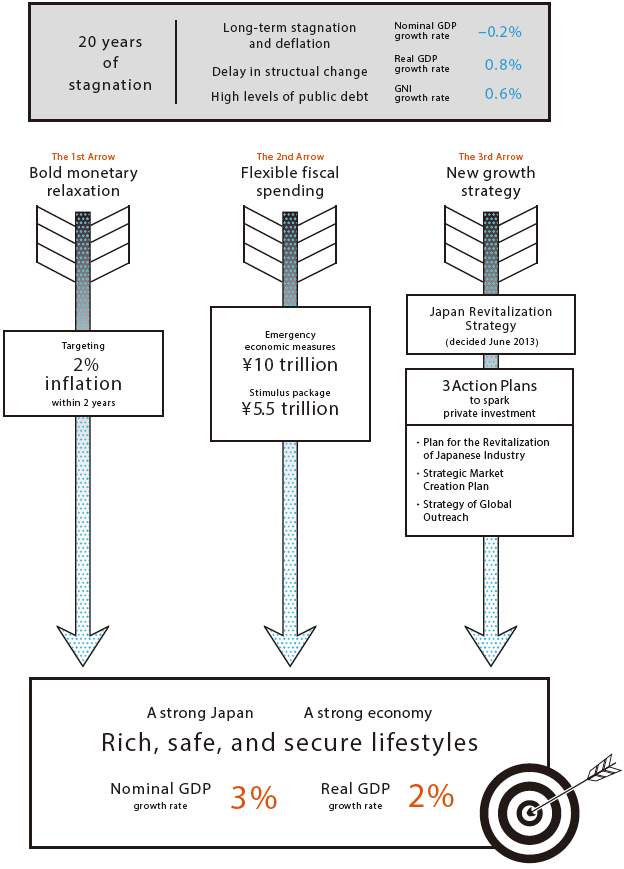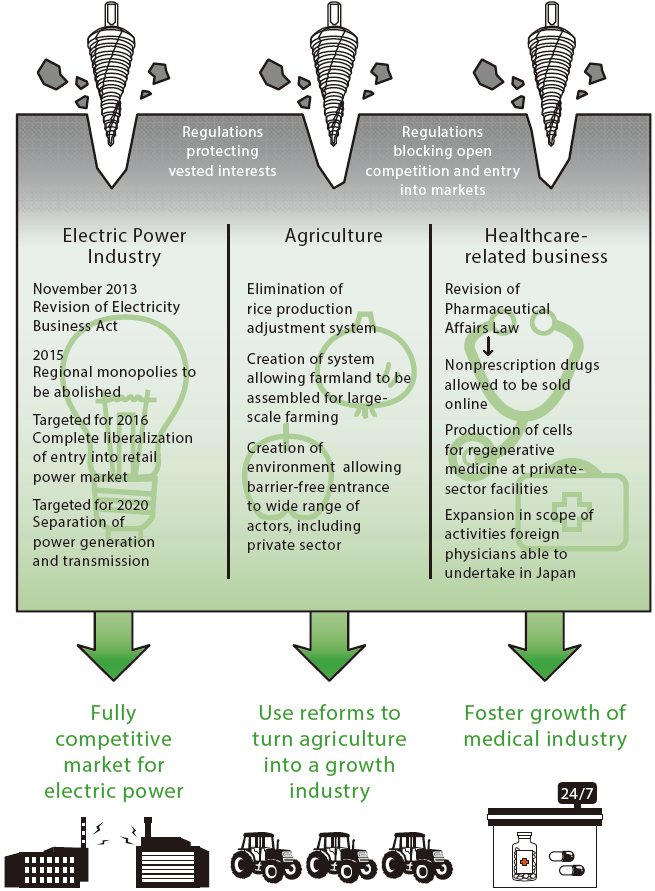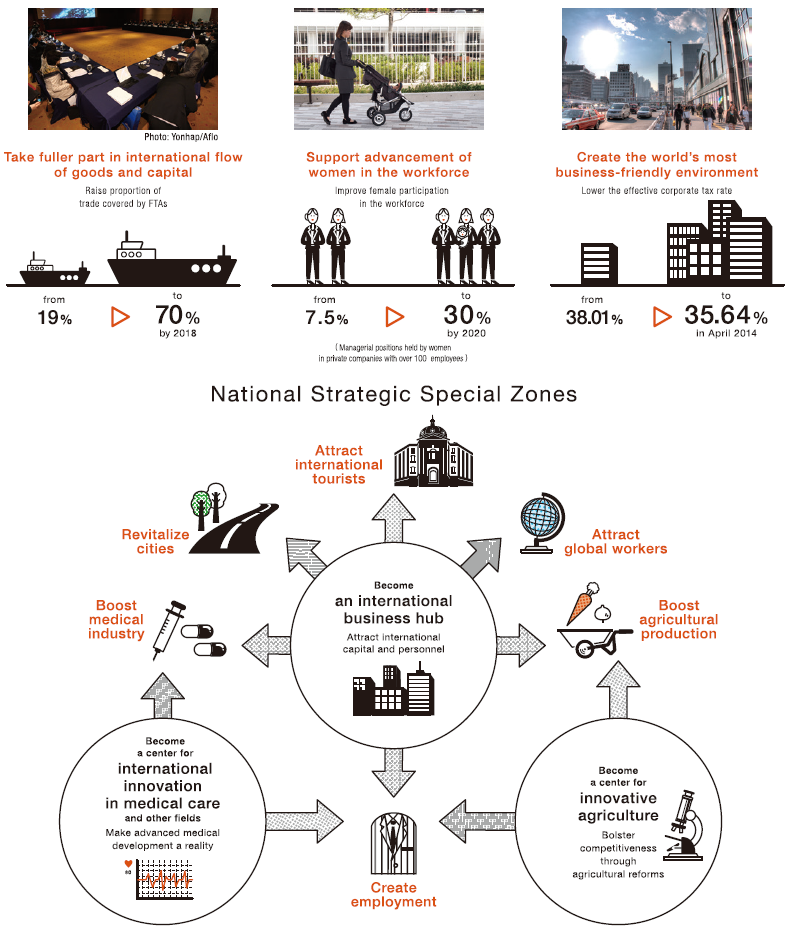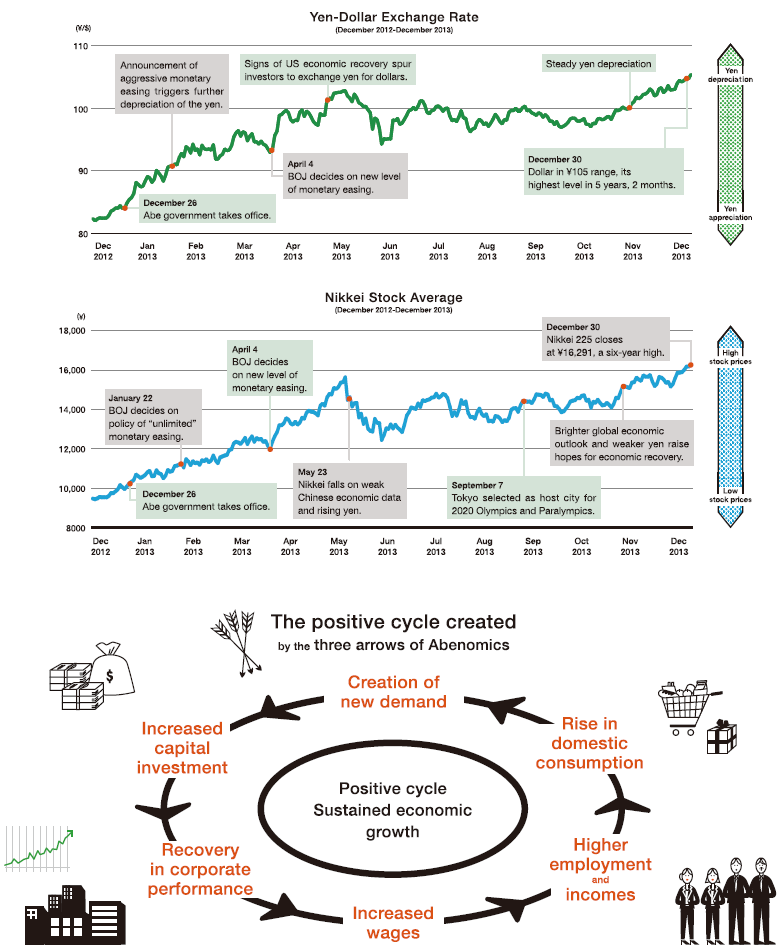Awaking from a deep sleep, you look out the window and see that the sky is pink. Is it sunrise or sunset? At first, you might not be sure.
For many years, people were talking about Japan as the land of the setting sun, a country that had passed its prime and was in decline. The economic mood was gloomy, and the combination of persistent deflation and an overvalued currency made it seem highly unlikely that the country would ever rise again.
Late in 2012, Prime Minister Shinzo Abe took office with a different message, promising to “take Japan back” to being the land of the rising sun. He immediately launched a drive to banish deflation and deal with the labor force reduction that is resulting from the low birthrate and aging of the population. Abe undertook to promote economic growth while cutting the fiscal deficit with a program that was soon dubbed “Abenomics,” which consists of what he called “three arrows”: 1) bold monetary relaxation; 2) flexible application of fiscal stimulus; and 3) a growth strategy to spark private investment.
In January 2013, less than a month after taking power, Abe shot off the first arrow, bold loosening of monetary policy. The Bank of Japan (BOJ) and the government issued a joint statement expressing their commitment to an inflation target of 2%. The BOJ followed up in April with the adoption of a framework for new quantitative and qualitative monetary relaxation. Haruhiko Kuroda, appointed by Abe as the central bank’s new governor, repeatedly stressed his commitment to achieving the 2% target. Thanks to the combination of clear words and firm deeds, the Japanese economy has made steady progress toward overcoming the deflation that dogged it for many years.
Also in January 2013, Abe shot his second arrow, flexible application of fiscal stimulus. His administration adopted a set of “Urgent Economic Countermeasures for the Revival of the Japanese Economy” involving ¥10 trillion in additional expenditure by the government and ¥20 trillion in total spending, including funds from local governments and the private sector. In October, the prime minister decided to go ahead with raising the consumption tax from 5% to 8% beginning in April 2014, a move aimed at improving the nation’s fiscal health. This is expected to cause a temporary downturn in consumer spending, and so in December the administration decided to put together another stimulus package, consisting of ¥5.5 trillion in government outlays and total spending of ¥18.6 trillion. Meanwhile, the government was able to cut the volume of new bond issues in the budget for fiscal 2014 by about ¥1.6 trillion, and the target of halving the deficit in the primary balance as a percentage of gross domestic product by fiscal 2015 now appears to be within reach.
The third arrow of Abenomics is a growth strategy to spark private investment, with a focus on regulatory reform. If we liken the first arrow to turning on the ignition of Japan’s rusty economic engine and the second arrow to stepping on the accelerator to give the engine gas, we might say that the third arrow is breaking through a barricade. The administration secured enactment of nine pieces of legislation for this purpose in last autumn’s extraordinary session of the National Diet; it plans to seek prompt passage of about 30 more related bills in the current Diet session.
Abe Drills Through the Bedrock of Vested Interests
Prime Minister Abe has called himself “a man with a drill,” likening Japan’s vested interests to bedrock and declaring that, “over the next two years, no vested interests will remain immune to my drill.”
Under a law enacted last autumn, the system of regional monopolies in the electric power industry—considered a prime example of bedrock regulation—will be abolished by 2015. And the prime minister’s drill will continue to cut through the bedrock in this field with further legislative initiatives to effect complete liberalization of entry into retail power transmission, targeted for 2016, and separation of power generation and transmission, targeted for 2020. The aim is to create a fully competitive market for electric power.
Reform is also progressing in the field of agriculture, which has been seen as another major hurdle. The government has decided to eliminate the rice production adjustment system (gentan) that has been in effect for over 40 years and to create a system to allow plots of farmland to be combined for large-scale farming. And it is aiming to relax controls so as to allow barrier-free entry to the agricultural sector, thereby turning it into a market where private-sector corporations can strive to hone their competitive strengths.
In addition, the Abe administration intends to improve the environment for healthcare– related businesses. It has already secured passage of a revision of the Pharmaceutical Affairs Law to allow virtually all nonprescription drugs to be sold online. In the field of regenerative medicine, in which Japan is a leader, new legislation will facilitate swift and safe practical use of regenerative technologies; in the future, private-sector plants will be allowed to generate cells for this purpose. And the administration is working toward expansion of the scope of activities in which foreign physicians may participate in Japan, along with the introduction of advanced forms of medical treatment.
All these were areas of bedrock regulation, long considered impossible to break. But Abe’s drill has already broken through some of them, and it is continuing to spin as the prime minister strives to get through the remaining ones over the coming two years.
Creating an Attractive Market and Improving the Environment for Innovation
The Abe administration is taking other moves to open up the Japanese market and make Japan a more attractive place to do business.
With the Trans-Pacific Partnership (TPP) and the proposed Economic Partnership Agreement (EPA) with the European Union, Japan will be able to take part to a greater extent in the international flow of goods, capital, and intellectual property. Currently only 19% of Japan’s trade is covered by free trade agreements; the government aims to raise this share to 70% by 2018.
Meanwhile, Japan needs to make its system of corporate taxes competitive by international standards. The combined rate of national and local taxes on corporate income is due to be lowered by 2.4% points in April, and the government has also introduced tax incentives to promote investment in highly productive equipment and to encourage corporations to use their cash reserves for capital investment, research and development, and wage increases.Additional reforms of corporate taxation will be undertaken during 2014.
On the financial front, last autumn the government came up with a plan to improve the investment and risk management of public and quasi-public assets, such as those of the Government Pension Investment Fund (GPIF). The forward-looking reforms implemented in keeping with this plan will bring a major change to Japan’s fund management. On the fundraising side, this spring the government plans to submit a bill to the Diet to make it easierfor enterprises to raise capital by promoting the use of crowd funding. And it is promoting the appointment of outside directors to corporate boards so as to strengthen corporate governance and support proactive management.
The Abe administration is also moving to boost Japan’s R&D power with the establishment of a Cross-ministerial Strategic Innovation Promotion Program (SIP) that will operate across the divisions among bureaucratic institutions and business fields and an Impulsing Paradigm Change Through Disruptive Technologies (ImPACT) program that will promote high-risk, highimpact R&D.
In addition, this spring “national strategic special zones” will be launched. The purpose of this new arrangement is to create hubs for international business and activities in fields like medical care and agriculture. It is expected that the new zones will promote the creation of an attractive environment for business with the relaxation of regulations on floor area ratios (building height) and urban planning controls, along with labor market reforms based on the drafting of new guidelines for employment rules. Deeper deregulation will be considered in line with the particular needs of the designated areas.
Of course, there are still some concerns about Japan’s future. One is the issue of the country’s low birthrate and aging population. How can Japan find the human resources to support its growth? One answer is to encourage talented foreigners to come to Japan. And anotherpromising avenue is “womenomics”—tapping the tremendous latent potential of Japan’s women. In order to allow women to shine as leading players in their workplaces, the government has been moving to improve the child-care support package and is offering assistance and tax breaks to encourage companies to tap women’s potential. The government is taking the initiative in promoting more women to management posts, and it is encouraging business corporations to do the same, with a target of raising the share of women in leadership positions to 30% by 2020. As Hillary Clinton told Prime Minister Abe, if women’s participation in the workforce were raised to the same level as men’s, Japan’s GDP wouldincrease by 16%. So Japan still has plenty of untapped power.
Japan’s Renewed Positive View of the Future
Earlier attempts to implement reforms aimed at vested interests in Japan generated loud opposition from the business world, the media, and others. But this time the response is quite different. Over the past year, Abenomics has produced a string of positive results, and it is widely supported by the public. The policies implemented by the Abe administration have been promoting a positive cycle of improved economic performance and increased confidence. The end of the deflationary spiral is finally in sight, and there are now hopes that businesses will raise wages. Abe and his team are working to ensure that the improvement in the economy is felt by people throughout the country.
In addition to spreading the gains throughout the country, it will also be important to put public finances on an even keel and promote confidence in the sustainability of the socialsecurity system. This will make it possible to achieve further progress in banishing deflation and putting the economy on a positive track. The Abe administration intends to keep up its efforts to address the remaining issues and accelerate the favorable trends. The Japanese people now seem to be orienting themselves in favor of reform. This may be a reflection of the paradigm shift caused by the Great East Japan Earthquake (March 2011).
Over the three years since this disaster, the nation has undertaken an all-out drive to rebuild and recover. And now the Japanese are finding a new sense of purpose, most notably from Tokyo’s successful bid to host the 2020 Olympics and Paralympics. We can sense a more positive mood—a readiness to build the future without fear of failure, to work at making dreams come true.
The economic engine of Japan has revved up, and the gas is flowing. It is ready to zoom forward. Meanwhile the prime minister’s drill is continuing to turn, breaking through remaining barriers. Abenomics is progressing, making the impossible possible.































































































































